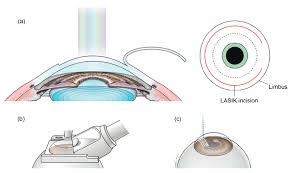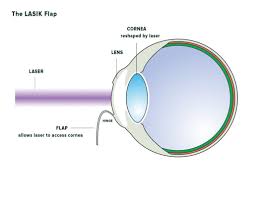Table of Contents
ToggleThe flap created during LASIK surgery is typically between 8 to 10 millimetres in diameter, depending on the size of the patient’s cornea and the eye surgeon’s assessment.
The flap has a thickness of 90 to 140 microns, customised to ensure precise results while maintaining corneal health.
LASIK, or Laser-Assisted in Situ Keratomileusis, is one of the most popular refractive surgeries for correcting vision issues such as myopia, hyperopia, and astigmatism. The formation of the corneal flap is a crucial step in the procedure, and understanding its size and role can help patients feel more informed and comfortable about undergoing surgery.
The Role of the Flap in LASIK
The corneal flap acts as a temporary “window” for the surgeon to access the middle layer of the cornea (the stroma) without disrupting the outer layer’s healing process. This allows the excimer laser to precisely reshape the cornea to correct refractive errors.
The flap is hinged, meaning it remains partially connected to the cornea for stability and ease of repositioning. Once the LASIK procedure is complete, the flap is gently placed back in position, where it naturally heals without the need for stitches.
The size and thickness of the flap influence the overall success and healing process of the surgery, making it a critical aspect of LASIK.
How Is the Flap Created?
Surgeons use two main methods to create the flap during LASIK surgery:
1. Microkeratome Blade
A microkeratome is a mechanical, precision instrument with an oscillating blade that cuts the flap. The blade’s depth is pre-set to ensure the right flap thickness. This method has been widely used for many years and is known for its effectiveness.
2. Femtosecond Laser
Femtosecond lasers enhance precision in creating the flap. This bladeless method uses ultra-fast pulses of light to create bubbles within the corneal tissue, which separate to form the flap. The femtosecond laser allows for better customisation of the flap’s shape, size, and thickness, often improving patient outcomes.
Surgeons choose the method based on the patient’s corneal structure, their experience, and the technology available at the clinic.
How Is the Size of the Flap Determined?
The flap’s size in LASIK is not a “one-size-fits-all” measurement. It is customised to the individual patient to optimise safety and outcomes. The following factors impact the size of the flap:
1. Corneal Diameter
The average human cornea is approximately 11.5 millimetres in diameter. While the LASIK flap typically ranges from 8 to 10 millimetres in diameter, the surgeon may adjust it to ensure the flap comfortably fits each patient’s anatomy.
2. Refractive Error Being Treated
Significant refractive errors often necessitate a larger flap to allow sufficient access and reshaping of the cornea. Customising the flap size ensures the laser has enough area to work effectively.
3. Corneal Thickness
Corneal thickness varies among individuals and is critical in determining the flap’s size and thickness. A surgeon will measure the corneal thickness with instruments like a pachymeter before surgery. Thinner corneas typically require thinner flaps to maintain structural integrity.
4. Type of Equipment Used
Microkeratomes and femtosecond lasers can generate flaps of different shapes and diameters. Femtosecond lasers, for instance, offer more flexibility in setting the flap parameters.
Why Is Flap Size Important?
The flap’s size and thickness significantly influence the safety and success of the surgery. Here’s why:
1. Ensures Corneal Stability
Creating a flap that is too large or too thick may compromise the cornea’s structural integrity, particularly in individuals with thin corneas. A smaller or thinner flap preserves corneal tissue and helps avoid complications like ectasia (corneal bulging).
2. Optimises Vision Correction
Having an appropriately sized flap ensures that the excimer laser can reshape the cornea accurately, leading to better long-term vision outcomes.
3. Supports Faster Healing
A well-proportioned flap minimises disruption to the cornea, allowing it to heal quickly and reducing the risk of post-surgical discomfort or inflammation.
4. Reduces Chances of Complications
Uneven or oversized flaps might lead to the development of issues like dry eyes, wrinkles in the flap, or difficulty repositioning. A correctly sized flap helps minimise these risks.
Is the Flap Permanent?
One misconception about LASIK is that the flap permanently “seals down.” While the flap naturally adheres back to the surface of the cornea after surgery, it remains delicately positioned for life. That’s why LASIK patients are advised to avoid rubbing their eyes, especially in the weeks following the procedure.
Although rare, the flap can be displaced by trauma or excessive force. This is why post-operative care and avoiding contact sports are crucial during the recovery period.
How Does the Flap Heal After LASIK?
The recovery process of the LASIK flap is one of the reasons the surgery has gained so much popularity. After the flap is repositioned:
- The cornea begins its natural healing process immediately.
- Epithelial cells (the outer corneal layer) start regenerating, sealing the flap in place.
- No stitches are required, as the flap adheres securely within a few hours.
- Most patients report improved vision within 24 to 48 hours.
To ensure optimal healing, patients must follow their surgeon’s post-operative instructions, which often include avoiding eye makeup, refraining from intense physical activity, and attending regular follow-up appointments.
Alternative Procedures Without a LASIK Flap
For individuals who may not be suitable candidates for LASIK due to thin corneas or other factors, alternative procedures avoid the creation of a corneal flap. These include:
1. PRK (Photorefractive Keratectomy)
PRK reshapes the corneal surface without creating a flap. It is a suitable option for patients with thin corneas but has a longer recovery time than LASIK.
2. SMILE (Small Incision Lenticule Extraction)
SMILE creates a small incision to remove a lenticule (a disc-shaped piece of corneal tissue), avoiding the need for a large corneal flap. This newer technique is gaining popularity for its minimal invasiveness.
Common Concerns About the LASIK Flap
Many patients worry about the flap creation process during LASIK surgery. Here are some frequently asked questions and their answers.
Q1. Does flap creation hurt?
No, flap creation is painless. Surgeons use numbing eye drops to ensure the patient is comfortable during the procedure.
Q2. Can the flap be felt?
During the surgery, you might feel slight pressure but no pain. Once the surgery is complete, the flap is barely noticeable.
Q3. Can the flap undo itself?
Flap dislodgement is rare but possible if there’s significant eye trauma. Surgeons always stress the importance of proper post-operative care to avoid such risks.
Final Thoughts
The flap created during LASIK surgery may only be 8 to 10 millimetres in diameter, but its significance cannot be overstated. It enables surgeons to correct vision effectively while prioritising corneal health and patient safety.
When considering LASIK, it’s important to choose an experienced surgeon, as the precision of flap creation plays a huge role in the procedure’s success. By understanding this critical step, you’ll be better equipped to make an informed decision about pursuing LASIK surgery.
For questions or concerns about LASIK, consult with a trusted ophthalmologist or refractive surgeon who can guide you through the process and address your unique needs. Your journey to a clearer vision begins with the right knowledge and professional care.













